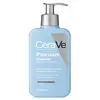What's inside
What's inside
 Key Ingredients
Key Ingredients

 Benefits
Benefits

 Concerns
Concerns

 Ingredients Side-by-side
Ingredients Side-by-side

Salicylic Acid 2%
MaskingWater
Skin ConditioningGlycerin
HumectantCapryl/Capramidopropyl Betaine
CleansingUrea
BufferingSodium C14-16 Olefin Sulfonate
CleansingShea Butteramidopropyl Betaine
CleansingPEG-150 Pentaerythrityl Tetrastearate
EmulsifyingLaureth-9
EmulsifyingSodium Lactate
BufferingNiacinamide
SmoothingEthoxydiglycol
HumectantSodium Chloride
MaskingGluconolactone
Skin ConditioningC12-13 Alkyl Lactate
EmollientCeramide NP
Skin ConditioningCeramide AP
Skin ConditioningCeramide EOP
Skin ConditioningCarbomer
Emulsion StabilisingSaccharide Isomerate
HumectantGlycolic Acid
BufferingCalcium Gluconate
HumectantSodium Benzoate
MaskingSodium Citrate
BufferingSodium Lauroyl Lactylate
EmulsifyingCholesterol
EmollientPhenoxyethanol
PreservativeDisodium EDTA
Tetrasodium EDTA
Citric Acid
BufferingHydrolyzed Hyaluronic Acid
HumectantLactic Acid
BufferingPhytosphingosine
Skin ConditioningXanthan Gum
EmulsifyingHexylene Glycol
EmulsifyingEthylhexylglycerin
Skin ConditioningBenzoic Acid
MaskingSalicylic Acid 2%, Water, Glycerin, Capryl/Capramidopropyl Betaine, Urea, Sodium C14-16 Olefin Sulfonate, Shea Butteramidopropyl Betaine, PEG-150 Pentaerythrityl Tetrastearate, Laureth-9, Sodium Lactate, Niacinamide, Ethoxydiglycol, Sodium Chloride, Gluconolactone, C12-13 Alkyl Lactate, Ceramide NP, Ceramide AP, Ceramide EOP, Carbomer, Saccharide Isomerate, Glycolic Acid, Calcium Gluconate, Sodium Benzoate, Sodium Citrate, Sodium Lauroyl Lactylate, Cholesterol, Phenoxyethanol, Disodium EDTA, Tetrasodium EDTA, Citric Acid, Hydrolyzed Hyaluronic Acid, Lactic Acid, Phytosphingosine, Xanthan Gum, Hexylene Glycol, Ethylhexylglycerin, Benzoic Acid
Water
Skin ConditioningDisodium Laureth Sulfosuccinate
CleansingGlycerin
HumectantSodium Cocoyl Isethionate
CleansingSodium Lauroamphoacetate
CleansingRosa Canina Fruit Extract
AstringentMyristoyl Tetrapeptide-13
Skin ConditioningAcetyl Carboxymethyl Cocoyl Glycine
Beta-Glucan
Skin ConditioningBisabolol
MaskingZingiber Officinale Root Extract
MaskingAvena Sativa Kernel Extract
AbrasiveSaccharomyces Lysate Extract
HumectantSodium Methyl Cocoyl Taurate
CleansingSalicylic Acid
MaskingHamamelis Virginiana Leaf Extract
Skin ConditioningCamellia Sinensis Leaf Extract
AntimicrobialAllantoin
Skin ConditioningEucalyptus Globulus Leaf Oil
PerfumingMenthol
MaskingXanthan Gum
EmulsifyingDisodium EDTA
Caprylyl Glycol
EmollientPhenoxyethanol
PreservativePotassium Hydroxide
BufferingWater, Disodium Laureth Sulfosuccinate, Glycerin, Sodium Cocoyl Isethionate, Sodium Lauroamphoacetate, Rosa Canina Fruit Extract, Myristoyl Tetrapeptide-13, Acetyl Carboxymethyl Cocoyl Glycine, Beta-Glucan, Bisabolol, Zingiber Officinale Root Extract, Avena Sativa Kernel Extract, Saccharomyces Lysate Extract, Sodium Methyl Cocoyl Taurate, Salicylic Acid, Hamamelis Virginiana Leaf Extract, Camellia Sinensis Leaf Extract, Allantoin, Eucalyptus Globulus Leaf Oil, Menthol, Xanthan Gum, Disodium EDTA, Caprylyl Glycol, Phenoxyethanol, Potassium Hydroxide
 Reviews
Reviews

Ingredients Explained
These ingredients are found in both products.
Ingredients higher up in an ingredient list are typically present in a larger amount.
Disodium EDTA plays a role in making products more stable by aiding other preservatives.
It is a chelating agent, meaning it neutralizes metal ions that may be found in a product.
Disodium EDTA is a salt of edetic acid and is found to be safe in cosmetic ingredients.
Learn more about Disodium EDTAGlycerin is already naturally found in your skin. It helps moisturize and protect your skin.
A study from 2016 found glycerin to be more effective as a humectant than AHAs and hyaluronic acid.
As a humectant, it helps the skin stay hydrated by pulling moisture to your skin. The low molecular weight of glycerin allows it to pull moisture into the deeper layers of your skin.
Hydrated skin improves your skin barrier; Your skin barrier helps protect against irritants and bacteria.
Glycerin has also been found to have antimicrobial and antiviral properties. Due to these properties, glycerin is often used in wound and burn treatments.
In cosmetics, glycerin is usually derived from plants such as soybean or palm. However, it can also be sourced from animals, such as tallow or animal fat.
This ingredient is organic, colorless, odorless, and non-toxic.
Glycerin is the name for this ingredient in American English. British English uses Glycerol/Glycerine.
Learn more about GlycerinPhenoxyethanol is a preservative that has germicide, antimicrobial, and aromatic properties. Studies show that phenoxyethanol can prevent microbial growth. By itself, it has a scent that is similar to that of a rose.
It's often used in formulations along with Caprylyl Glycol to preserve the shelf life of products.
Salicylic Acid (also known as beta hydroxy acid or BHA) is a well-known ingredient for treating skin that struggles with acne and clogged pores. It exfoliates both the skin's surface and deep within the pores to help clear out buildup, control oil, and reduce inflammation.
Unlike AHAs (alpha hydroxy acids), salicylic acid is oil-soluble. This allows it to penetrate into pores which makes it especially effective for treating blackheads and preventing future breakouts.
Salicylic acid is also known for its soothing properties. It has a similar structure to aspirin and can calm inflamed or irritated skin, making it a good option for acne-prone skin that is also sensitive.
Concentrations of 0.5-2% are recognized by the U.S. FDA as an over-the-counter topical acne product.
It can cause irritation and/or dryness if one's skin already has a compromised moisture barrier, so it's best to focus on repairing that before introducing this ingredient into your routine.
While salicylic acid does not increase sun sensitivity, it’s still important to wear sunscreen daily to protect your skin.
If you are looking for the ingredient called BHA or Butylated Hydroxyanisole, click here.
Learn more about Salicylic AcidWater. It's the most common cosmetic ingredient of all. You'll usually see it at the top of ingredient lists, meaning that it makes up the largest part of the product.
So why is it so popular? Water most often acts as a solvent - this means that it helps dissolve other ingredients into the formulation.
You'll also recognize water as that liquid we all need to stay alive. If you see this, drink a glass of water. Stay hydrated!
Learn more about WaterXanthan gum is used as a stabilizer and thickener within cosmetic products. It helps give products a sticky, thick feeling - preventing them from being too runny.
On the technical side of things, xanthan gum is a polysaccharide - a combination consisting of multiple sugar molecules bonded together.
Xanthan gum is a pretty common and great ingredient. It is a natural, non-toxic, non-irritating ingredient that is also commonly used in food products.
Learn more about Xanthan Gum